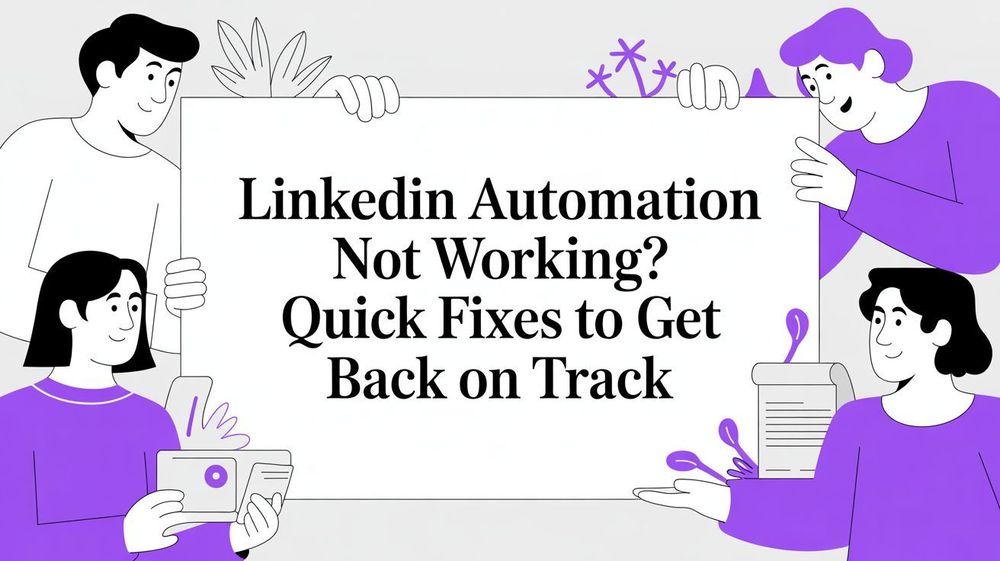Marketing automation is more than sending emails on a schedule; it’s the engine for scaling personalized communication, nurturing leads, and driving revenue without constant manual effort. The challenge isn't deciding if you should automate, but understanding what to automate and how. A poorly designed workflow can feel robotic and alienate customers, while a strategic one guides prospects seamlessly from first contact to conversion, feeling like a one-on-one conversation.
This guide moves beyond theory to provide practical, replicable marketing automation workflow examples from leading platforms. We'll break down the triggers, actions, and goals behind each workflow, offering a clear blueprint you can adapt. A core challenge for sales and recruiting is populating these workflows with high-quality leads. This is where manual data entry or complex coding creates a bottleneck. A modern no-code tool like ProfileSpider solves this by letting you scrape profiles from LinkedIn, GitHub, or Facebook and export them directly into your CRM or marketing platform, feeding your automation engine in one click.
We will explore detailed analyses and actionable takeaways for key use cases, including customer onboarding, re-engagement campaigns, and abandoned cart recovery. Each example is designed to help marketers, sales teams, and recruiters identify the right automation strategy to save time and create more meaningful customer interactions.
1. HubSpot
HubSpot stands out as a premier platform for creating comprehensive marketing automation workflow examples, largely due to its powerful, all-in-one approach. It combines a user-friendly visual workflow builder with a deeply integrated CRM, allowing businesses to automate processes across marketing, sales, and service departments. This tight integration means workflows can be triggered by and act upon a vast range of data points, from contact properties and website activity to deal stages and support ticket statuses.
What truly sets HubSpot apart is its goal-based workflow structure and extensive template library. Instead of starting from scratch, users can select a pre-built template designed for a specific objective, like nurturing leads or re-engaging cold contacts. The drag-and-drop editor simplifies the process of adding actions, such as sending emails, creating internal tasks, or using "if/then" branching logic for hyper-personalized journeys. This makes it an ideal choice for teams seeking both simplicity and sophisticated customization. To discover more about its capabilities, you can learn more about HubSpot on profilespider.com.
Key Features & User Experience
HubSpot’s platform is designed for clarity and efficiency. The interface is clean, and the community-sourced workflow library provides endless inspiration and practical solutions shared by other users. This collaborative element is invaluable for discovering new strategies.
- Pricing: HubSpot offers a free CRM, but its powerful workflow automation features are primarily available in the Marketing Hub Professional (starting at $800/month, billed annually) and Enterprise tiers.
- Pros: The seamless CRM integration is its greatest strength, enabling highly contextual and data-rich automation. Its extensive documentation and active community provide excellent support.
- Cons: The cost can be a significant barrier for smaller businesses, as advanced automation is locked behind pricier plans. Higher-tier plans may also include mandatory onboarding fees.
For businesses that can leverage its full suite of tools, HubSpot provides a robust foundation for building, managing, and optimizing sophisticated marketing automation workflows that drive measurable results.
Website: https://www.hubspot.com
2. Mailchimp
Mailchimp has earned its place as a go-to platform for marketing automation workflow examples, particularly for small teams and growing businesses. Its strength lies in its approachable design and extensive library of pre-built templates, or "journeys." These templates cover essential use cases like welcoming new subscribers, winning back lapsed customers, and recovering abandoned carts, allowing users to launch effective automations with minimal setup. The platform demystifies automation, making it accessible even to those without deep technical expertise.
What makes Mailchimp particularly compelling is its visual drag-and-drop journey builder, which clearly maps out the customer path. Users can easily add starting points, if/then branching logic, time delays, and actions like sending emails or SMS messages. For US-based users on Standard plans or higher, Mailchimp is also integrating AI-assisted, brand-aware email generation directly into its templates, further speeding up the content creation process. This focus on simplicity and guided setup provides a powerful yet manageable entry point into the world of marketing automation.
Key Features & User Experience
Mailchimp’s interface is designed for clarity, with template previews that show exactly what a journey will do and what triggers it requires before you even select it. The journey builder is intuitive, though some users report occasional quirks or limitations compared to more enterprise-level platforms.
- Pricing: Mailchimp offers a free plan with limited automation capabilities. More advanced, multi-step journeys are available in the Essentials plan (starting at $13/month), with the most powerful features found in the Standard plan (starting at $20/month) and higher.
- Pros: The platform is incredibly user-friendly, making it ideal for teams just starting with automation. Its extensive library of integrations connects seamlessly with many e-commerce and business tools.
- Cons: The most sophisticated automation features and branching logic are reserved for paid tiers. The journey builder can feel less flexible than more advanced competitors for highly complex, multi-channel workflows.
For businesses seeking a straightforward, effective solution to automate core marketing tasks, Mailchimp provides an excellent balance of power and usability, helping them build and execute valuable workflows without a steep learning curve.
Website: https://mailchimp.com
3. ActiveCampaign
ActiveCampaign excels in providing accessible yet powerful marketing automation workflow examples through its extensive library of pre-built "automation recipes." This platform is designed for businesses that want to implement sophisticated, multi-step sequences quickly without building them from the ground up. By offering over 200 templates for common marketing and sales scenarios, ActiveCampaign empowers users to deploy everything from welcome series to abandoned cart reminders with just a few clicks.
The key differentiator for ActiveCampaign is that its automation recipes are not just static templates; they are fully functional workflows that can be imported directly into an account using a simple wizard. This process maps the template's logic, emails, and tags, significantly reducing setup time. Its visual builder then allows for easy customization, letting users add or modify steps to fit their unique strategy. This combination of a vast template library and a flexible editor makes it a top choice for teams that value both speed and control in their automation efforts.
Key Features & User Experience
ActiveCampaign’s interface is centered around its visual automation builder, making it intuitive to see how a contact moves through a workflow. The marketplace of recipes, including community and paid creator options, offers a near-endless source of inspiration and practical, replicable strategies for marketers.
- Pricing: Automation templates are available on all plans. The Plus plan (starting at $49/month, billed annually) is a popular entry point, with more advanced features like conditional content and lead scoring available on higher-tier plans. Pricing is contingent on the number of contacts.
- Pros: The ability to rapidly deploy complex workflows from a huge library of templates is a major advantage. Its strong segmentation capabilities, combined with multi-channel triggers on higher plans, allow for highly personalized customer journeys.
- Cons: The most powerful features are reserved for the Pro and Enterprise tiers. The contact-based pricing model means costs can escalate quickly as your list grows, requiring careful plan selection.
For businesses looking to launch proven marketing automation workflow examples with minimal friction, ActiveCampaign provides an unparalleled library of ready-to-use recipes backed by a robust and scalable platform.
Website: https://www.activecampaign.com
4. Klaviyo
Klaviyo has carved out a niche as a powerhouse for ecommerce brands, offering a platform specifically designed to drive sales through highly targeted marketing automation. Its strength lies in its deep, native integrations with major ecommerce platforms like Shopify, BigCommerce, and Magento. This connection allows Klaviyo to pull in rich customer data, such as purchase history, browsing behavior, and cart activity, which serves as the foundation for creating incredibly effective marketing automation workflow examples.
What makes Klaviyo a top choice for direct-to-consumer businesses is its extensive "Flow Library." This library is filled with battle-tested templates for essential ecommerce scenarios like welcome series, abandoned cart recovery, customer win-back campaigns, and post-purchase follow-ups. These pre-built workflows provide a clear and practical starting point, guiding users on which channels (email or SMS) to use at each stage. The visual builder then allows for easy customization, enabling brands to tailor messaging and timing based on robust segmentation and event-based triggers that are specifically designed for a retail environment.
Key Features & User Experience
Klaviyo’s user experience is geared toward action and results, especially for marketers who are not technical experts. The interface makes it simple to understand customer lifecycle stages and build corresponding automations. Partner-submitted flow templates also expand the library, offering even more creative strategies.
- Pricing: Klaviyo's pricing is primarily based on the number of active email and SMS contacts. A free plan is available for up to 250 contacts and 500 email sends. Paid plans scale up from there, for example, the Email plan for up to 1,500 contacts starts at $45/month.
- Pros: Its specialization in ecommerce is a major advantage, providing unparalleled data integration and relevant workflow templates for online retailers. The platform’s focus on direct-to-consumer automation delivers clear, practical value.
- Cons: The cost can grow quickly as a brand’s contact list expands, as pricing is directly tied to the number of active profiles. Recent changes to its billing policies may also affect the overall cost for some users.
For any ecommerce brand looking to implement sophisticated, revenue-driving automation, Klaviyo provides a specialized and powerful toolset that is both accessible and deeply capable.
Website: https://www.klaviyo.com
5. GetResponse
GetResponse positions itself as an accessible yet powerful platform for small and medium-sized businesses looking to implement marketing automation workflow examples without a steep learning curve. Its core strength lies in a vast library of over 40 pre-built, goal-oriented workflow templates. This allows users to quickly launch sophisticated campaigns for lead nurturing, subscriber scoring, abandoned cart recovery, and webinar promotions, significantly reducing setup time and technical barriers.
What makes GetResponse particularly effective is its combination of a user-friendly visual workflow editor with detailed educational resources. Each template is accompanied by step-by-step guides and instructional videos, empowering marketers to not only implement but also understand the logic behind each automation sequence. This focus on education and practicality makes it an ideal choice for teams that want to achieve tangible results quickly, without needing a dedicated automation specialist.
Key Features & User Experience
GetResponse’s interface is designed for speed and clarity, with a drag-and-drop builder that makes visualizing complex journeys simple. The pre-configured triggers, conditions, and actions within the templates cover a wide range of common marketing scenarios, from e-commerce sales funnels to online event management.
- Pricing: GetResponse offers several tiers. Automation features are included in the Marketing Automation plan (starting at $41.30/month, billed annually) and above. A generous 30-day free trial is available to test these premium features.
- Pros: The extensive template library provides immense value and accelerates implementation, making it perfect for SMBs. The platform is very user-friendly and supported by excellent learning resources.
- Cons: Some of the most advanced automation and e-commerce functionalities are reserved for the higher-priced plans, which might be a limitation for businesses looking to scale their operations significantly.
For businesses seeking a straightforward, template-driven approach to marketing automation, GetResponse offers a robust and cost-effective solution that balances ease of use with powerful capabilities.
Website: https://www.getresponse.com
6. Salesforce Marketing Cloud
Salesforce Marketing Cloud is an enterprise-grade platform built for crafting sophisticated, multi-channel customer journeys. Its core automation tool, Journey Builder, allows marketers to design intricate workflows that span email, mobile, advertising, and the web. This platform excels at orchestrating complex data from multiple sources, making it a powerhouse for large organizations that need to deliver personalized experiences at a massive scale. It is designed for deep integration within the broader Salesforce ecosystem, connecting marketing actions directly to sales and service data.
What makes Salesforce Marketing Cloud a top choice for creating marketing automation workflow examples is its scalability and extensibility. Users can start with pre-built journey templates that offer in-product guidance, simplifying the initial setup for common scenarios like onboarding or re-engagement. For more advanced needs, the AppExchange allows for the integration of custom activities, such as adding SMS providers directly into a journey canvas. This adaptability ensures that as a business's marketing strategy evolves, the platform can evolve with it. You can learn more about Salesforce on profilespider.com to see how it fits into a larger sales and marketing tech stack.
Key Features & User Experience
Journey Builder provides a visual canvas that, while powerful, carries a steeper learning curve than more simplified tools. It's built for marketers who need granular control over every touchpoint in a customer's lifecycle and have the technical resources to support complex data integrations.
- Pricing: Pricing is highly customized and typically geared towards enterprise clients. It is quote-based and varies significantly depending on the specific "Clouds" (e.g., Email, Mobile, Journey Builder) and features required.
- Pros: Its enterprise-grade functionality and powerful data orchestration capabilities are unmatched for large-scale operations. The extensive ecosystem via the AppExchange provides immense flexibility for specialized integrations.
- Cons: The platform's cost and complexity can be prohibitive for small to mid-sized businesses. It requires a significant implementation effort and often dedicated technical expertise to manage effectively.
For large enterprises managing vast amounts of customer data across numerous channels, Salesforce Marketing Cloud offers an unparalleled foundation for building and executing highly personalized and scalable automation workflows.
Website: https://www.salesforce.com
7. Adobe Marketo Engage
Adobe Marketo Engage is a powerhouse in the marketing automation space, designed for enterprise-level organizations that require deep, sophisticated workflow capabilities. Its core automation engine, "Smart Campaigns," allows marketers to build intricate, multi-step journeys based on a vast array of triggers, from behavioral data like web page visits and email clicks to demographic and firmographic details within its native database. This platform is built for complex, long-term lifecycle marketing where precision and scalability are paramount.
What sets Marketo Engage apart is its sheer flexibility and depth. Users can create workflows using triggers, batch processing, smart lists, and a series of flow steps to execute actions like sending emails, changing data values, or pushing leads to a CRM. While it doesn't offer a simple drag-and-drop visual builder like some competitors, its logic-based interface provides unparalleled control for crafting highly customized marketing automation workflow examples. This makes it ideal for businesses that need to manage complex lead scoring, nurturing, and sales alignment processes. To dive deeper into its capabilities, you can learn more about Adobe Marketo Engage on profilespider.com.
Key Features & User Experience
Marketo’s platform is geared toward experienced marketing operations professionals who can leverage its powerful, rules-based system. The user experience prioritizes functional depth over visual simplicity. The rich ecosystem of official and third-party templates for emails, landing pages, and web campaigns provides a solid foundation for building out campaigns.
- Pricing: Marketo Engage pricing is not publicly listed and is tailored to each business. It typically requires direct engagement with their sales team for a custom quote, reflecting its enterprise focus.
- Pros: Its enterprise-grade flexibility allows for incredibly detailed and powerful automation. The extensive ecosystem, including partner templates and integrations, extends its capabilities significantly.
- Cons: The platform has a steep learning curve, and implementation can be a substantial, time-consuming project. The lack of transparent pricing can be a barrier for companies in the evaluation stage.
For large organizations with dedicated marketing operations teams, Adobe Marketo Engage offers an exceptionally robust framework for executing complex, data-driven automation strategies at scale.
Website: https://business.adobe.com/products/marketo/marketo-engage.html
Marketing Automation Workflow Comparison
| Platform | Implementation Complexity | Resource Requirements | Expected Outcomes | Ideal Use Cases | Key Advantages |
|---|---|---|---|---|---|
| HubSpot | Moderate; drag-and-drop, some coding | Professional/Enterprise tiers for advanced features | Customizable, goal-based workflows | Marketing, sales, service automation | Strong CRM integration, active community support |
| Mailchimp | Low to Moderate | Paid tiers for advanced flows | Pre-built marketing flows with AI email support | Small teams, growing businesses | Easy onboarding, extensive integrations |
| ActiveCampaign | Moderate | Features limited by plan/contact size | Rapid deployment of complex workflows | Marketing and sales automation | Large library of automation recipes |
| Klaviyo | Moderate | Pricing scales with active profiles | Ecommerce-focused lifecycle automations | Ecommerce, direct-to-consumer brands | Deep ecommerce platform integration |
| GetResponse | Low | Higher tiers unlock advanced functions | Quick implementation, broad marketing coverage | SMBs needing ready-to-use workflows | Step-by-step guides, large template gallery |
| Salesforce Marketing Cloud | High | Significant implementation effort and cost | Enterprise-grade multi-channel orchestration | Large enterprises with complex needs | Powerful orchestration, extensive app ecosystem |
| Adobe Marketo Engage | High | Substantial implementation effort and sales engagement | Sophisticated lifecycle marketing automation | Enterprise complex lifecycle marketing | Deep automation capabilities, rich third-party ecosystem |
From Examples to Execution: Building Your Automation Engine
We've explored a wide range of powerful marketing automation workflow examples, from HubSpot's lead nurturing sequences to Klaviyo's intricate e-commerce automations. Each example demonstrates a core truth: effective automation creates intelligent, responsive, and personalized customer journeys at scale. However, a great workflow is useless without high-quality data to fuel it.
This is where the process often breaks down for recruiters and sales teams. Manually searching for profiles on LinkedIn or GitHub and copy-pasting data into a CRM is slow and prone to errors. Writing custom code to scrape this data is a non-starter for non-technical users. ProfileSpider was built to solve this exact problem. It's the no-code, AI-powered tool that lets you build candidate and lead lists in one click. You can scrape profiles from multiple social platforms and export the data directly into your marketing automation tool, creating a seamless bridge between lead generation and lead nurturing.
Your Action Plan for Implementation
Translating these ideas into a functional system requires a clear, strategic approach. Don't try to build everything at once.
- Start with Your Biggest Pain Point: What is the biggest bottleneck in your pipeline? Is it converting new leads? Re-engaging dormant prospects? Prioritize the workflow that will deliver the biggest impact first.
- Map the Journey Manually: Before you touch a single tool, sketch out the ideal path. What triggers the workflow? What is the first message they should receive? What happens if they engage versus if they don’t? This manual map becomes your blueprint.
- Choose the Right Tools for the Job: As our examples show, different platforms excel in different areas.
- For Lead Generation: Use a no-code tool like ProfileSpider to build your contact lists quickly.
- For Sales and Marketing Alignment: HubSpot or Salesforce offer integrated CRM and automation.
- For Sophisticated E-commerce: Klaviyo's deep integration is unmatched.
- For SMBs & Content Creators: Mailchimp or GetResponse provide user-friendly solutions.
Final Thoughts on Building Your Engine
Implementing these workflows is a marathon, not a sprint. It involves careful planning, consistent testing, and a willingness to adapt based on data. To effectively build your automation engine and streamline operations, you can benefit from resources on mastering marketing workflow automation to deepen your understanding of the strategic principles involved.
The most successful automation strategies are living systems, continuously optimized based on performance. The marketing automation workflow examples in this guide are starting points. Combine them with a powerful, no-code data source like ProfileSpider to build an engine that not only saves you time but also cultivates stronger, more profitable relationships.




